Safety is one of the top priorities of RV manufacturers. Every year they add more features to improve vehicle safety, but sometimes safety defects do happen.
Since the National Traffic and Motor vehicle Safety Act was passed in 1966 granting the authority to the National Highway Traffic Safety Administration (NHTSA) to enforce vehicle recalls, more than 390 million cars, trucks, buses, recreational vehicles, motorcycles, and mopeds have been recalled. There have also been recalls of over 46 million tires, 66 million pieces of motor vehicle equipment, and 42 million car seats due to safety defects.
Not all RV recalls are about safety issues, but many are. If your RV or tow vehicle has one and you don’t know about it, you can be putting yourself and your passengers in danger.
What Is One of The Most Ignored RV Safety Issues?
Unresolved or Open Safety Recalls on RVs and their safety equipment, including tires and tow vehicles is one of the most ignored safety issues.
You May Have a Recall and Not Know it
If you bought your RV from a dealership, chances are they checked for recalls and repaired them before you took delivery. This actually happened to us with our Newmar.
BIG TIP- If you bought your RV from a private owner, it’s very important that you check the RV VIN number on the NHTSA website BEFORE you take delivery to be sure that all open recalls have been taken care of at a dealership capable of performing the repairs.
Want to skip to a section to learn more?
Click on the Table of Contents links below to get to that section of the article.
What Happens After a Safety Recall Is Issued?
How Are You Notified of Recalls?
Get Notified Automatically of Safety Recalls
How To Check for Safety Recalls Yourself- 2 Simple Steps
How Search For RV and Vehicle Recalls
What do VIN Searches Look Like
How to Search For Tire Recalls and Safety Issues and Complaints
What To Do If Your Vehicle Has Been Recalled
Do You Have To Pay For Recalls
How Long Do You Have to Take Your Vehicle In For a Free Recall Repair
How Long Do You Have For Tire Recalls
Already Paid For a Safety Related Recall? You May Get Your Money Back
What is a Safety-Related Defect?
Safety-Related Defect Examples
Non-Safety-Related Defect Examples
What To Do If You Think You Have a Safety Defect
What is a recall
There are federal motor safety requirements that all vehicle and equipment manufacturers are required to meet.
If it is determined, either by government investigation or manufacturer’s admission, that one or more of those Federal Safety Requirements is violated or not met, then a recall is issued.
Who issues RV Recalls
The National Highway Traffic Safety Administration (NHTSA) has the authority to issue safety recalls, but sometimes the manufacturers themselves will voluntarily initiate recalls.
When Is a Recall Necessary?
There are Federal Motor Vehicle Safety Standards that are required of all vehicles and vehicle-related equipment manufactured or imported for sale in the United States and U .S. territories that are certified for use on public roads and highways.
Those Safety Standards have established minimum performance requirements for the parts of the vehicle that most affect its safe operation. This includes brakes, tires, airbags, seat belts, lighting, or anything that protects drivers and passengers from death or serious injury in the event of a crash.
A recall will be issued if a motor vehicle or item of motor vehicle equipment (including tires) does not comply with a Federal Motor Vehicle Safety Standards.
Also, if it is discovered that there is a safety-related defect in the vehicle or equipment, a recall will be issued.
What Happens After a Safety Recall Is Issued?
After a safety recall, manufacturers are required to fix the problem at no charge to the owner. The NHTSA will continue to monitor the recall to ensure that the manufacturer did complete the repairs.
When a safety defect is discovered, the manufacturer is required to notify the NHTSA, vehicle distributors, dealers, and owners.
How Are You Notified of Recalls?
Manufacturers are required to notify all registered owners and purchasers of affected vehicles of recalls by first class mail, using addresses they obtain from state motor vehicle offices.
But what if your contact information has changed and the state information hasn’t been updated yet? You can sign up to receive email recall notifications from the NHTSA.
Tip: Normally, the dealer updates warranty records with new owners’ names and forwards to the manufacturers of major coach components. If you bought a pre-owned coach, contact the RV manufacturer, the chassis manufacturer, and the engine manufacturer to make sure they have updated warranty records with your name.
How To Get Automatically Notified of Safety Recalls
You don’t have to rely on Dealers or Manufacturers to notify you of recalls. You can register your contact information on the official NHTSA website or download the Safercar mobile app for iPhones or Safercar mobile app for Androids to have recall alerts sent to your phone. That way you aren’t relying on the manufacturer to try and track you down to alert you of recalls, especially if you are always traveling!
You can register up to 5 vehicles on the recall notification site. Here’s what the registration form looks like:
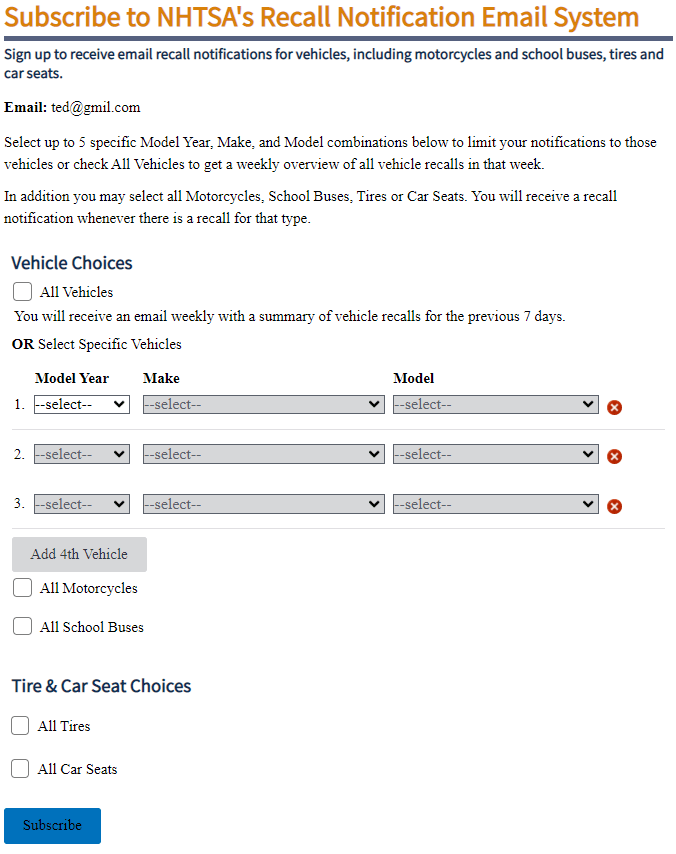
2 Simple Steps To Check for Safety Recalls
Even though you may have registered your contact information with your vehicle and tire manufacturers, it’s always a good idea to check the NHTSA website at least twice per year to verify your vehicles and tires have no open recalls.
Tip: Non-safety recalls, Safety recalls for vehicles older than 15 years or vehicles with repaired safety recalls will not be shown in the search tool.
Checking for recalls is very easy and can be done in 2 simple steps:
How Search For RV and Vehicle Recalls
- Obtain your Vehicle Identification Number (VIN). You can find your VIN number on the lower left side of the driver’s side windshield, your registration or your insurance card. Here’ a graphic courtesy of the NHTSA website showing where to look on your vehicle:
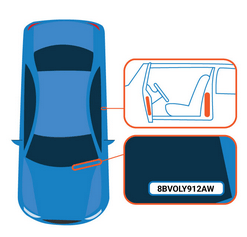
- Go to the official government recall site and enter your VIN, and that’s it! You can see all the OPEN recalls. You will not see recalls that have been repaired already. Here’s the link that will take you to the NHTSA site: NHTSA.gov
Here’s an example
of the LP tank hanger recall on the Entegra Coaches, note that it
specifies the RV Model (QWEST) and the RV Years covered under the
recall (2018-2020) and how many coaches were affected (447).
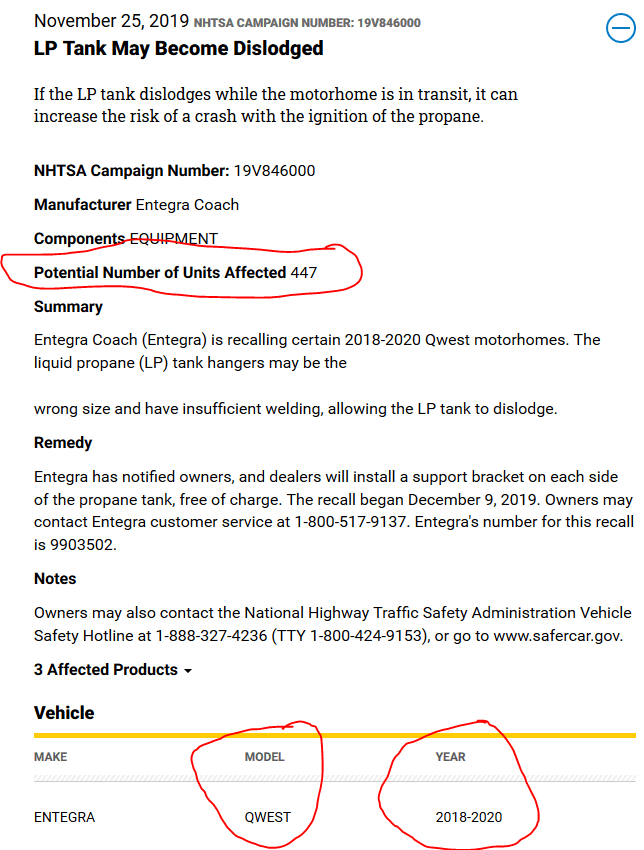
What Does An RV VIN Recall Search Tell You
There are three different recall status types that can be displayed when you search your VIN in the NHTSA site:
- Recall INCOMPLETE – This means that an incomplete or “open” recall was found for the vehicle and you should follow the remedy instructions found in the notice.
- Recall INCOMPLETE. Remedy Not Yet Available – This means that an incomplete or “open” recall was found on the vehicle, but the manufacturer is not yet ready to provide the needed remedy or fix. You want to contact your dealer and ask them to schedule you for service when the repair is available.
- Number of Open Recalls: 0 – This means that either you have no recalls associated with your RV or it has already been fixed.
What
you hope to see when you look up your RV VIN number on the NHTSA
website. This is what we found when we looked up our RV- 0 Unrepaired
Recalls!
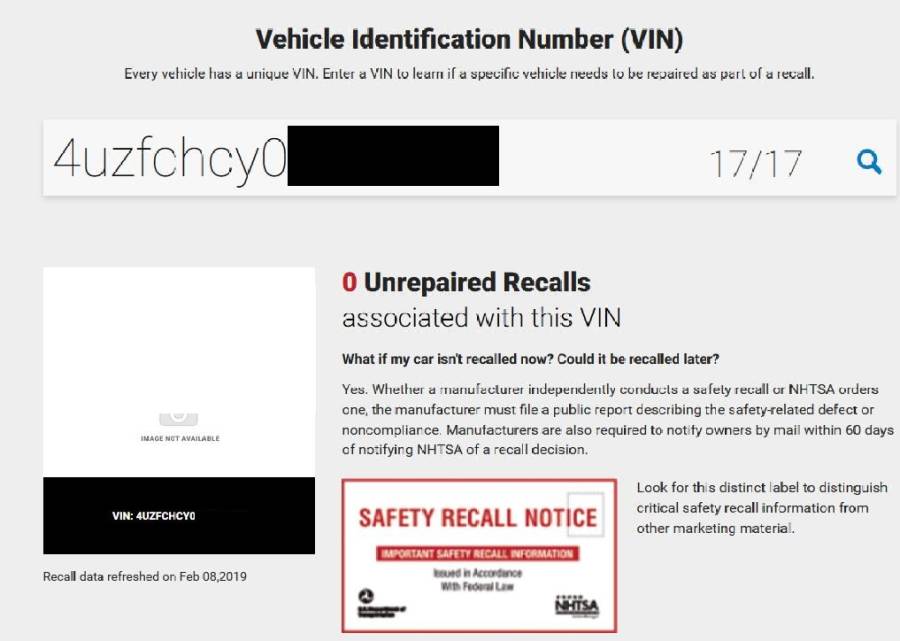
Tip: The NHTSA site can also tell you about tire recalls.
How to Search For Tire Recalls and Safety Issues and Complaints
Federal law requires that all tires sold in the U.S. contain a full TIRE IDENTIFICATION NUMBER or TIN on at least one side of the tire sidewall. The full number must begin with the letters DOT and ends with a 4 digit number indicating the date of manufacture.
- Looking at your tire, find the brand and TIN number of your tires.
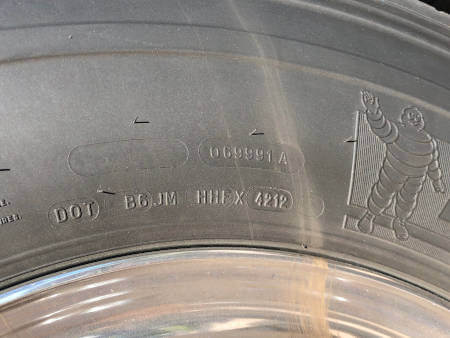
- Using the same site as above when searching your RV VIN, click on the Tire Recall tab and enter your brand and TIN. Here’s the link that takes you to the NHTSA Tire Recall tab: NHTSA-Tires
Tip- You can enter just your tire brand and line in the search box, but without knowing your actual Tire Identification Number you will not know whether the tires you have are included in a recall.
Here’s an example of a recent tire recall campaign found on the NHTSA website. In addition to identifying the Safety Issue and the specific tires affected, note that under the Remedy Section, it tells you how to get your tires replaced free.
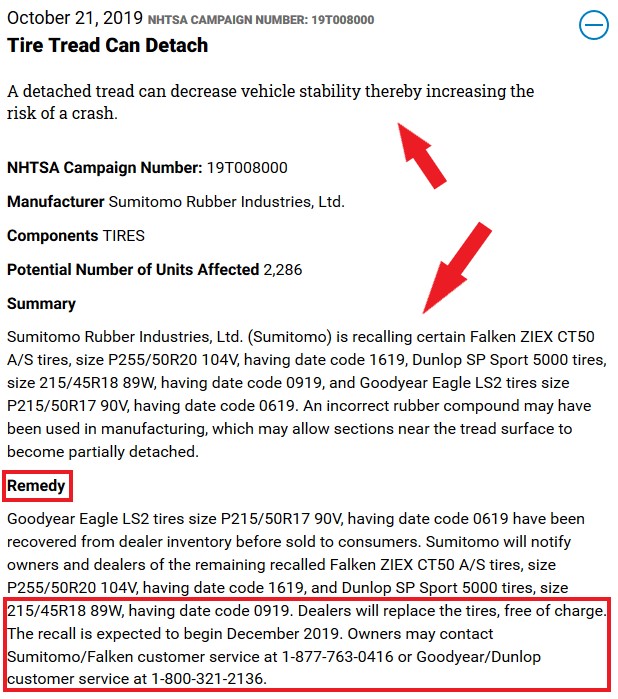
Tip: In addition to checking your RV and RV tires for recalls, be sure to check your tow vehicle and tow vehicle tires for recalls at the official website of the NHTSA.
What To Do If Your Vehicle Has Been Recalled
If you receive a notification of a recall or safety improvement campaign, the notification will tell you what safety precautions you should take while you are awaiting repairs. Make sure you follow any interim safety guidance provided by the manufacturer and contact your local dealership immediately.
Do You Have To Pay For Recalls
No, if your vehicle is less than 10 years old you do not have to pay for safety recalls. The dealer will fix the recalled part or portion of your vehicle or equipment for free. Even if your vehicle is more than 10 years old, it’s still worth asking the manufacturer if they will cover the repairs.
If a dealer refuses to repair your vehicle in accordance with the recall letter, you should notify the manufacturer immediately. You can also file a complaint with NHTSA at www.safercar.gov and provide as many details as possible, including the name of the dealership and any personnel involved
How Long Do You Have to Take Your Vehicle In For a Free Recall Repair
In the case of vehicles, free recall repairs are only covered until the vehicle is 10 years old from the original date of sale. Don’t wait to get your recall repairs done, otherwise, you may be stuck paying the bill yourself.
How Long Do You Have For Tire Recalls
According to the NHTSA, “the law requires tire manufacturers to repair or replace at no cost to the consumer only those tires purchased within five years of the defect or noncompliance determination. In order to obtain free replacement or repair of a recalled tire, consumers must bring the tire to the dealer within 60 days of receiving the recall notification letter from the manufacturer.”
If the replacement tires are not in stock, be sure to get documentation from the dealer acknowledging they will replace them at no charge when they are available.
Already Paid For a Safety Related Recall? You May Get Your Money Back
The reimbursement policy is a fairly new requirement. Under certain conditions manufacturers are required to provide reimbursement for costs incurred by owners to remedy safety defect conditions prior to a recall.
The deadlines for reimbursement are very specific, and you need to have complete documentation proving that the repairs you paid for were directly related to the recall.
If you believe you are entitled to a refund, ask your dealer to help intervene to get your money back from the manufacturer.
What is a Safety-Related Defect?
The United States Code for Motor Vehicle Safety (Title 49, Chapter 301) defines motor vehicle safety as “the performance of a motor vehicle or motor vehicle equipment in a way that protects the public against unreasonable risk of accidents occurring because of the design, construction, or performance of a motor vehicle, and against unreasonable risk of death or injury in an accident, and includes nonoperational safety of a motor vehicle.”
A defect includes “any defect in performance, construction, a component, or material of a motor vehicle or motor vehicle equipment.”
Basically, a safety defect is a problem that exists in a vehicle or equipment that poses an unreasonable risk to safety and may exist in a group of vehicles or equipment of the same design or manufacture.
Safety-Related Defect Examples
One of the most recent and well-known safety-related recalls was the Takata Airbag Recall. Investigations after multiple crashes showed that long-term exposure to high heat and humidity can cause the airbags to explode when deployed. Those explosions caused injuries and deaths.
Other safety-related defects include steering components that break suddenly, fuel system components that cause fires or even windshield wiper assemblies that fail to operate properly.
Non-Safety-Related Defect Examples
Not all defects are considered safety-related. Ordinary wear and tear is not considered safety-related, nor is rust, or radios or air conditioners that do not operate properly. It needs to be a defect that hinders the safe operation of the vehicle due to the way it was manufactured to qualify as a safety recall.
What To Do If You Think You Have a Safety Defect
If you think your vehicle has a safety defect, stop using it immediately and report it to the NHTSA Vehicle Safety Hotline at 888-327-4236 or 800-424-9393. They will document your information and provide further advice or forward to their technical staff for evaluation.
You can also report a vehicle safety issue to the NHTSA online at their vehicle safety website: NHTSA.gov Select “File a Complaint” within the Defects and Recalls section of the home page.
Make sure you pay attention to vehicle and equipment Safety Recalls. Your safety and the safety of your passengers depends on it!
